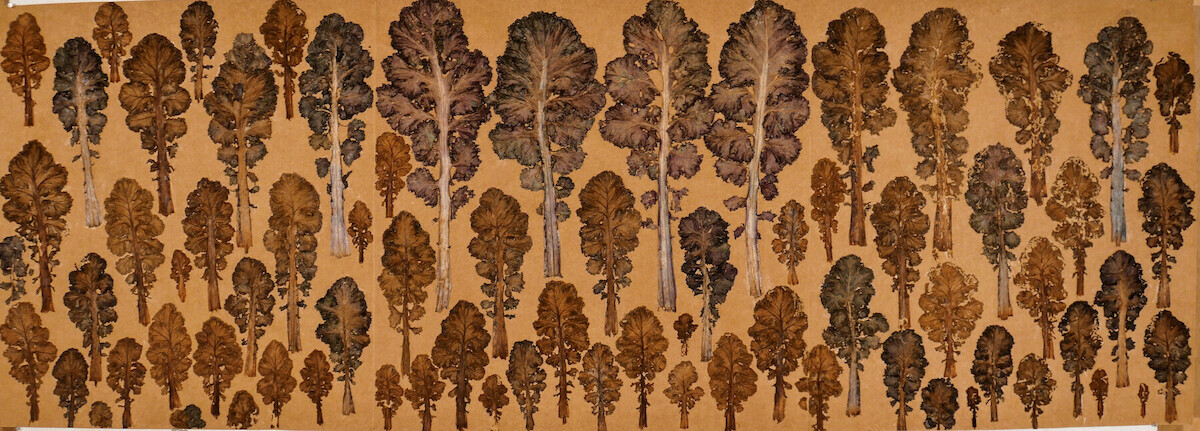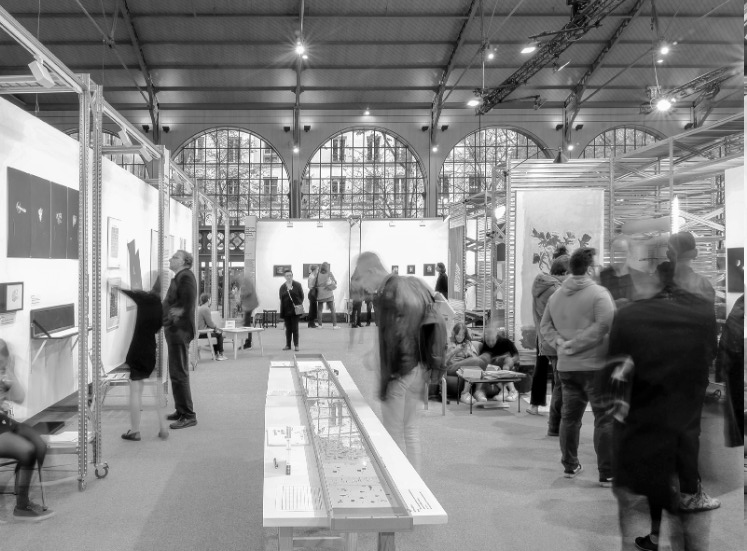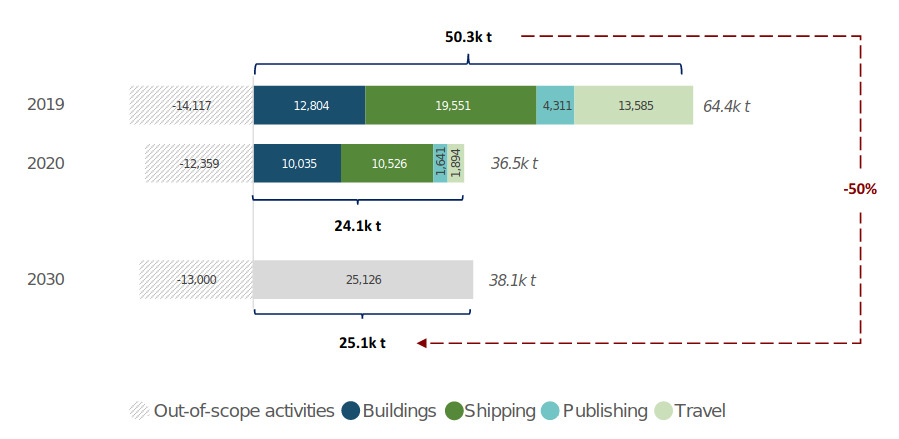The Art Market and the Environment : The secondary market
[06/05/2022]The art world is belatedly but resolutely waking up to its environmental impact and its eco-responsibilities. Artprice has redacted three articles on the challenges and expectations facing the art world in its efforts to clean up its act. The first looks at the initiatives adopted by the art market (essentially the auction/art fair sphere). The second will focus on artists who are committed to the environmental issues, and the third will focus on the challenges facing the online art sphere as it seeks to adopt a more sustainable and eco-friendly model.

Marinette Cueco, Crambe Maratima, chou marin, 2008. Art Paris Art Fair
In recent years, awareness of the art world’s environmental impact has been growing rapidly, driven by a range of different factors. These include a number of government initiatives, many of which flowed from the Paris Agreement signed in 2016, and the global impact of Covid-19 pandemic which made the art world more conscious of its digital potential. In Paris, for example, the Louvre museum and the Drouot group (auction operator) now have dedicated Environment Officers who are responsible for sustainable development. The result is the design and adoption of a number of completely new initiatives, from the recycling of waste to the renovation of part of the heating and air conditioning systems; from the introduction of biodiversity into the Tuileries Gardens, to the reorganization of several exhibitions hosted by Paris-Musées under the same roof. Every aspect of the creation, presentation, conservation and transport of artworks has been analyzed from an environmental perspective. New resources have been made available to professionals such as the Arts Reserve, which collects materials used in art fairs and exhibitions and then makes those materials available to art schools notably. A government website https://www.dons.encheres-domaine.gouv.fr/ now exists for the sharing of materials and structures between institutions and associations officially recognized as being of ‘public interest’. It is therefore clear that France’s public cultural establishment (museums and their supervisory authorities, amongst others) have been actively pursuing ecological targets since the 2010s. But what about the broader art market?
“At Christie’s we understand that the experience of art is positive and meaningful, a source of personal joy and enrichment as well as a privilege. This experience, however, should not come at the expense of the environment.” Guillaume Cerutti, CEO.
Being by nature what might be described as a circular economy”, the art auction market should be capable of presenting itself a model of virtuous eco-responsibility. But it is part of a global mechanism involving numerous international art fairs, from Basel to Miami, from Maastricht to Hong Kong, and the transport of artworks all over the planet. It also involves a lot of air travel by collectors and VIPs, single-use installations and the storage of works that consume a lot of energy… A leaflet distributed by the “Le Bruit qui court” collective at the last FIAC (Paris’s International Contemporary Art Fair) criticized the fair as being inaccessible, expensive (to set up) and energy-consuming.
Such criticism may well be valid, but awareness of environmental issues within the art market community has made a real difference in recent years. The subject was tackled head on last November 2021 during an “Art Market Day” at the Pompidou Center in Paris. The museum hosted a round table titled How to reduce the ecological impact of the art market? The major art fairs have answered this question with figures: in Paris, the FIAC (International Contemporary Art Fair) claims to have recycled 44% of its waste in 2019. The same year, Art Basel had set up carbon offsetting scheme during its Miami edition.
Here is a brief overview of the aspects of the art market with the heaviest carbon footprints… and some of the solutions proposed by the art market.
Transportation
The art auction industry’s carbon emissions are typically related to shipping and logistics around the consignment and delivery of artworks and the management of internal processes. A significant part of an auction house’s environmental footprint may also be related to building maintenance and business travel. Towards the end of 2019, Christie’s published an analysis of these factors. In a single year, the auction house produced 33,743 cubic tons of carbon and other greenhouse gasses. This is approximately equivalent to the annual emissions of 7,300 family cars. The environmental cost of transporting people and artworks is therefore high, and this cost is only marginally reduced by online sales. The International Exhibition and Fine Art Transporters Green Committee is working on solutions to limit this pollution, including the use of bio-fuels, hybrid vehicles and training road users to adopt “eco-driving”. A number of art market players and art transporters have understood the advantages of pooling transport, thereby reducing both the ecological impact of transport and its financial cost.
Energy savings
Art fairs have also communicated their efforts (and results) in terms of energy consumption. Initiatives range from using LED lighting or more energy-efficient air conditioning systems, to the production of digital tickets and sales catalogs. The vertiginous acceleration of the digitization of the art market is one of the most visible consequences of the pandemic. In its 2020 annual report, LiveAuctioneers, for example, declared that it saved 68 tons of paper thanks to online auctions. Meanwhile, gallery owners and fair operators have become more aware of their role in this new dynamic. Some have adopted private initiatives aimed at reducing their carbon footprints on a daily basis: stopping the distribution of plastic water bottles, finding more sustainable partners for the floral decoration of certain events, reusing the materials used to package art works, etc.
Structures and scenography

Galeristes, scenography by Dominique Perrault et Gaëlle Lauriot-Prévost
With Paris’s Grand Palais closed (since end-2020) for renovation, a temporary structure, designed by architect Jean-Michel Wilmotte, has been built near the Eiffel Tower to host the FIAC, Art Paris, Paris-Photo and Paris’s fashion shows. Made entirely of wood as a disassemblable structure, it can be reused for multiple projects. Nevertheless, this virtuous example cannot hide the fact that for the majority of events organizers, financial considerations usually play a decisive role. Most salons and fairs seem reluctant to pay more for reusable and convertible presentation systems (often as much as 15% more), particularly as they are emerging from two years of substantial pandemic-related difficulties. Some do, however. Since its launch Galeristes has used modules inspired by the industrial designs of Dominique Perrault and Gaëlle Lauriot-Prévost which have now become very much part of the visual identity of their fair (at the Carreau du Temple in Paris). These modules offer greater flexibility and allow each edition to propose new scenographies depending on the number and size of the galleries present. It is therefore not just possible… it’s advantageous!
Such practices and the ecological considerations underlying their implementation are not easy to adopt. They require specific tools, the use of measurement data and certain technologies that art market players are usually not familiar with. A number of new players are now contributing to the generalized adoption of sound eco-responsible practices.
New players
Fostering a greener art market is not going to happen by itself! In France, Alice Audouin is the pioneer of sustainable development in the field of art, founder of Art of Change 21 and co-founder of the French association COAL Art & Développement Durable. In her view, “The first thing to do if we want a more ecological art sector is to work with the best engineers and bring them together to create data and tools that are accessible to all” Curator of the Art and Environment section of the recent Art Paris Art Fair, she is working on a Best Practices guide, co-written with Fanny Legros (founder of the consulting agency @Karbone). The Professional Committee of Art Galleries (CPGA) is also working to raise awareness of environmental issues amongst its members in collaboration with the Sustainable Art Market agency via a platform for the reuse and pooling of scenographic materials (Plinth).

Christie’s GHG commitment for 2030
In recent years, collaborative initiatives such as the Gallery Climate Coalition (GCC), Art to Zero, and the MOCA Los Angeles Climate Committee have taken concrete steps to facilitate the ‘decarbonization’ of the art sector and promote zero-waste practices. Based in London and Berlin, the GCC provides galleries, artists and member auction houses (notably Christie’s) with an application that calculates their carbon footprint based on flights, shipments, energy-consumption, packaging, printing, etc. Its members are committed to obtaining estimates and carbon audits of their activities and to reducing their carbon footprints by 50% over the next ten years. Christie’s, which joined the group last March, wants to double that goal – committing to net-zero carbon emissions by 2030 – by driving change across all areas of its activities from shipping and business travel to energy consumption and waste. Tom Woolston, Christie’s Global Head of Operations and Sustainability Programs has clearly indicated that this bold decision by one of the world’s leading auction houses is a direct consequence of the environmental concerns of its clients and collectors.
The influence of collectors
The activities of sales operators are one thing. But what about the consumers? There is increasing evidence that they have become central to raising awareness of environmental risks. In recent years, a new generation of younger collectors has entered the art market and their behavior is substantially different from an environmental perspective. So-called ‘millennials’ (where women are a little more present), spend more and resell faster than their ‘baby-boom’ elders. Highly familiar with online communication, codes and practices, their first purchases are often made via social networks or online sales or fairs, and they expect a market in line with their convictions: the sustainability of the art industry and the impact of its carbon footprint are among their main concerns. The younger generation of millennials is particularly sensitive to environmental issues with 70% considering it essential to reduce their environmental footprint related to their art purchasing practices.
Julia Stoschek, a major German collector of contemporary art, points to the lessons learnt from the pandemic, notably regarding temporary artistic events. “If there’s one thing we’ve learned during this pandemic, it’s that we can all fly a lot less.” Auction houses and art dealers are therefore encouraged by their clients to make the industry more environmentally respectful. They frequently receive requests for local deliveries of artworks by electric or hybrid vehicles, or in the framework of carbon offsets. Collector Patrizia Sandretto Re Rebaudengo believes that supporting climate-conscious artists is also a key way to invest in changing mentalities.
The global art market – which again generated more than $17 billion in auction turnover in 2021 – is only at the very beginning of the process of environmental self-regulation. For the new initiatives implemented to grow and develop across the industry, it needs the commitment of all its participants, big and small. Accompanied by the ‘new players’, the establishment of best practices will be all the more effective if observers, regulatory authorities and collectors conscientiously avoid the temptation of ‘greenwashing’.




 0
0
